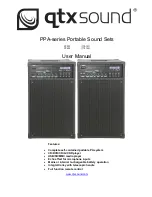
&
User
AN-80i
Manual
70-00072-01-08b
Proprietary Redline Communications © 2009
Page 38 of 128
June 4, 2009
Local Frequency Ranges:
These are the (optional) scan intervals for this PTP Slave. The last settings saved in
non-volatile memory will be loaded when the PTP Slave is rebooted.
Remote Frequency Ranges:
When settings are displayed in this table, the frequency scan intervals have been
downloaded from the PTP Master. Setting scan intervals in the PTP Master is
optional. When present, these settings override the local settings and are used
whenever the PTP Slave has deregistered and is scanning for a PTP Master. This
list is not saved permanently, and is discarded when the PTP Slave is rebooted.
Reload
: Display the saved (Local) scan intervals.
Save
: If settings are valid, the ranges are added to the Local Frequency Range list.
An event message is logged indicating the results of the test.
Important
: Clicking the Save button does not permanently save changes. You must
click Save at the bottom of the
System Configuration screen
.
Test
: Click to check the range settings and add these to the Local Frequency Range
list (if valid). This action does not save the changes to non-volatile memory.
Operating Notes
PTP Slave: When no frequency ranges are entered (default), the PTP Slave scans all
available frequency ranges for that region (see 8.5: Regional Codes on page 123).
When one or more frequency ranges have been entered, only these frequency ranges
are scanned. If all entered frequency ranges are scanned (x3) without registering with a
PTP Master, the PTP Slave defaults to scanning all enabled frequencies.
PTP Master: The PTP Master can be used to provide a master list of frequency ranges.
When a PTP Slave is registered, all entered frequency ranges are downloaded and
displayed as Remote Frequency Ranges on the PTP Slave. Downloaded Remote
Frequency Range settings are used exclusively during autoscan, and remain in effect
until the PTP Slave is rebooted.
Tx Power [dBm]
: Enter the transmit power level (dBm). This setting is for the
transceiver output only. The actual EIRP depends on the gain of the connected antenna.
Refer to the following tables to determine the maximum transmit power level available at
each modulation setting. When ATPC is enabled, the Tx power is automatically adjusted
to achieve optimum performance. When DFS is enabled, the subscriber Tx power may
be automatically adjusted (regardless of ATPC setting) to avoid false DFS triggering.
Table 4: Web - PTP Maximum TX Power Settings (dBm)
Modulation
BPSK
QPSK
16 QAM
64 QAM
Code Rate
1/2
3/4
1/2
3/4
1/2
3/4
2/3
3/4
Max. Tx Power
:
T35 Radio
25 25 25 25 25 23 22 21
Max. Tx Power:
T49, T54,
and T58 Radios
25 25 23 22 21 20 18 17
Notes:
1.
Tx power settings apply to: PTP v3.00 and higher and PMP v11.0 and higher
2.
.
In PMP mode, setting the Tx power too high may reduce the SINADR value. If the
SINADR is less than expected, re-test the link using a lower Tx power setting.
3.
Refer to Table 5: Web - PTP Modulation/Coding vs UBR on page 40 for
modulation/coding.
















































